Single Spotlight: Rivals of Ixalans’ Dino Destruction

Hi, and welcome back to the Single Spotlight – the series in which I cover some of the most powerful cards to show up in Standard, and break down what they have to offer the format.
Pre-release has come and gone, and the various tribes of Ixalan have made their way into the hands of players everywhere. The Merfolk and their tyrannical ruler Kumena have already made a splash on Magic Online, and the fiery Pirates are swashbuckling their way into mono-Red shells all over. Mono-White and BW Vampires have taken a bite out of many aspiring brews, powered by the new Legion Lieutenant and such efficient threats as Skymarcher Aspirant. One tribe I’m yet to see much of, however, is arguably the most anticipated to be released in well… ever: the Dinosaurs.
The Dinos of Ixalan were a powerful breed to be sure, with such midrange standouts as Ripjaw Raptor and Regisaur Alpha, alongside sideboard staple and Scavenging Ooze’s second cousin (on his mother’s side), Deathgorge Scavenger. While a lot of the tools were already there, Dino midrange felt like just a weaker RG shell when compared to the powerhouse that was Temur Energy. So, what did Rivals bring into the equation? Can the Dinos stand tall alongside the giants of Standard, with Grixis Energy, mono-Red and UB Control? Let’s take a look!
The Cards
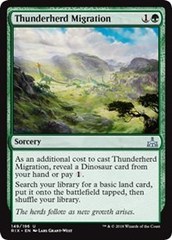
Starting at the bottom of the curve, we have Standard’s newest Rampant Growth impressionist. While this one isn’t as close a comparison as it’s modern counterparts Farseek and Sakura Tribe Elder, it’s far and away more powerful than it’s most recent incarnation, Ruin in their Wake.
Thunderherd Migration is pretty straight-forward – without any Dinos, it’s a Cultivate that doesn’t draw you an extra land. With Dinos, however, it jumps you straight from two to four mana. This is big news for Ramp decks everywhere.
Now, why is this big news? Otepec Huntmaster, Drover of the Mighty and even Servant of the Conduit all do the same thing. The difference lies in it’s card type. As a Sorcery, no-one is going to be pointing a Fatal Push at it, nor an Essence Scatter or Abrade. Cheap, uninteractive Ramp is highly sought after, and for good reason. Actual Rampant Growth or Signets have been deemed too powerful for Standard for years now, and it’s because of this very card that I think a Dino Ramp deck is even viable. High praise indeed!
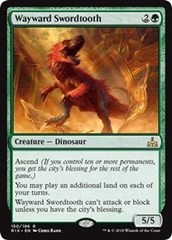
Next, we have the biggest, baddest Explore you’ve ever seen.
Wayward Swordtooth does something Ramp decks always want – it acts as mana ramp early, and a threat late. While it doesn’t produce mana itself, relying on you holding excess lands for it to function, when it works, it does work. A three drop that immediately ramps you by a land and then threatens to take chunks out of the opposing life total is not to be trifled with. As a bonus, it’s size makes it immune to the front half of Fatal Push, basically every Red burn spell but Harnessing Lightning, and it can even tussle with The Scarab God once the game goes long. This is not a beastie you want to be on the wrong side of.
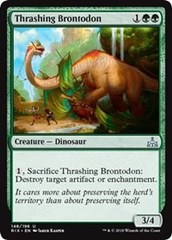
In the running theme of spells on sticks, meet the new Naturalise.
Thrashing Brontodon is an extremely versatile card. As a 3/4 for 1GG, it’s below rate for a vanilla Standard threat, but on a highly playable sideboard card it’s more than big enough. This long-necked monster blocks everything out of Red but Hazoret, everything out of Vampires and everything but the fliers in Mardu Vehicles (though spoiler warning: it can handle a Heart of Kiran without breaking a swear). On top of all of this, it’s a fantastic answer to God Pharoah’s Gift, Anointed Procession, and even a rogue Vanquishers’ Banner. Whether in Dino Ramp or in the sideboard of anything that can cast it, I’d expect to see a lot of this guy in new Standard.
Right, we’ve done our time looking at the ramp and utility on offer – what does Rivals have to offer us in terms of raw beef?
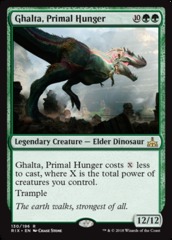
Ask and you shall receive.
Ghalta is huge. Like, really huge. A 12/12 trample is no joke, and while it offers no protection for it’s huge cost, what it does offer is a massive discount on that price – alongside massively inflated creature stats like Heart of Kiran and Rhonas the Indomitable, this mighty king of the Jurassic threatens to join the fray as early as turn four. Turn four! That is in no way reasonable.
Now, Ghalta is by no means unassailable. The Ravenous Chupacabra makes mincemeat of it (though I don’t want to imagine the logistics behind that encounter; the little doggy must be real hungry), and cards like Vraska’s Contempt and even a fully powered Harnessed Lightning get rid of it sharpish. Even if the opponent has a Deathtoucher like Gonti, Lord of Luxury or Gifted Aetherborn, you’re getting in for a whopping seven-nine damage. When it cost you between circa six and two mana, that seems more than fair. When they don’t have an answer? CRUNCH.
Ghalta is big. Very, very big. He’s also Green, and kinda dumb. For the more discerning caster of giant things, let’s check out the next card.
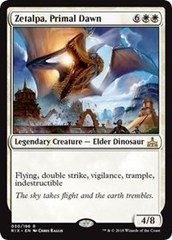
My Akroma, Angel of Wrath, what big teeth you have!
Zetalpa is not a hard card to evaluate. As a 4/8 Indestructible, it’s not dying to anything short of Vraska’s Contempt or a counterspell. Vigilance means that it gets to play both side of the fence, swooping in for disgustingly large amounts of damage via Double Strike, and defending it’s owner against any and all threats. Lastly, it’s evasion in Flying and Trample means your opponent really can’t do a lot except get cut to ribbons. Honestly, I’m shocked that Wizards didn’t just throw a Hail Mary and give this Lifelink and all – as it is, it’s a pretty great threat, but doesn’t quite stabilise the board well enough for my liking.
In a Ramp deck, this seems more like a sideboard card against removal heavy shells than a main-deck bomb. Still, I challenge you to not enjoy the design of this monster. It is literally BIGGER THAN THE SKY.
Now, we’ve one last card to go, and boy, is this a doozie. Given that it’s the thumbnail image, I don’t imagine I’m surprising any of you, but still – check this out.
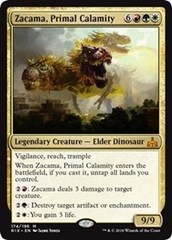
You want a nine drop? BAM.
Zacama is the be-all and end-all of Dinosaur Ramp monstrosities. Sure, Ghalta is bigger, and yes, Zetalpa is harder to kill. That really doesn’t matter. Zacama comes down, rebuys every last bit of mana you used to cast it, then starts throwing Lightning Bolts, Naturalises and Healing Salves all over the shop. Hell, you can even cast another huge beastie in the same turn if you’re so inclined – Zacama into Wakening Sun’s Avatar or Gishath, Sun’s Avatar is just totally unfair! That doesn’t even count the times you find Zacama using Gishath, and get immediately disqualified for having KO’d your opponent through sheer card-based ferocity.
As you can see, Rivals decided to go a step bigger than did it’s predecessor Ixalan – the Dino decks it encourages aren’t interested in playing fair with Ripjaw Raptors and Deathgorge Scavengers. They want to make a ton of mana and slam Zacama on the table. I approve.
The Deck
So, with so many options to work with, where should you start?
First off, I’d take Ghalta out of the running. While he’s quite the threat, he’s also way too easy to interact with, and does very little on defense. When you’re spending the first few turns of the game barely affecting the board, you need your payoff to catch you up – Ghalta is better suited to being the top end of a Midrange shell, and for that reason, he’s out.
Second, Zetalpa misses the cut for the same reasons as Ghalta. While she’s a much better blocker, she also only blocks one creature, and by the time you’re putting an eight on the table you may well have a whole of bunch of critters to deal with.
So, what giant payoffs do you want? Gishath, Wakening Sun’s Avatar and Zacama fit the bill nicely. Wakening Avatar catches you right back up, while Gishath and Zacama threaten to put so much power on the table that the game ends on the spot. On the way there, you’re going to want a whole bunch of Ramp and some removal to buy you time; something like this:
Naya Dino Ramp
| 13 Creatures | 23 Lands |
| 4 Wayward Swordtooth | 4 Sheltered Thicket |
| 4 Regisaur Alpha | 4 Rootbound Crag |
| 2 Wakening Sun’s Avatar | 3 Inspiring Vantage |
| 2 Gishath, Sun’s Avatar | 4 Hashep Oasis |
| 1 Zacama, Primal Calamity | 1 Shefet Dunes |
| 4 Forest | |
| 24 Non-Creature Spells | 3 Mountain |
| 4 Commune with Dinosaurs | |
| 4 Thunderherd Migration | Sideboard |
| 4 Abrade | 3 Carnage Tyrant |
| 4 Sweltering Suns | 4 Ripjaw Raptor |
| 4 Gift of Paradise | 4 Deathgorge Scavenger |
| 4 Hour of Promise | 2 Thrashing Brontodon |
| 2 Chandra, Torch of Defiance |
Ignoring the four-drop slot entirely does weaken Thunderherd Migration somewhat, but following it with a three mana ramp spell and an Abrade seems like a pretty good way to bridge the gap to me!
With either a Thunderherd, Wayward or Gift of Paradise, you’re looking at a turn four Hour of Promise into a turn five eight-drop. Your four Commune with Dinosaurs act as both a Lay of the Land and a Traverse the Ulvenwald, switching between finding lands or threats as required.
By moving all of your midrange threats to the board, you immunise the deck from removal in game one – when the opponent then brings in their countermagic and discard, you bring in the Raptors, Planeswalkers and Carnage Tyrants. This deck should run rampant over any Midrange shell, put up a fight against aggro, but struggle against Control – if your meta is dominated by Fumigate decks, then I’d look at either bringing Zetalpa to the party or trying something else!
Summary
And that’s the Dinosaurs of Ixalan. I hope you’ve found this piece illuminating, and are excited to ride the Regisaur Alpha and it’s brethren into battle Huatli-style!
Got ideas on how else to build this sort of deck? Maybe you want to be a clever girl and jam Raptors in the main? Whatever your thoughts, share them in the comments below. As always, thanks for reading, and good luck.





